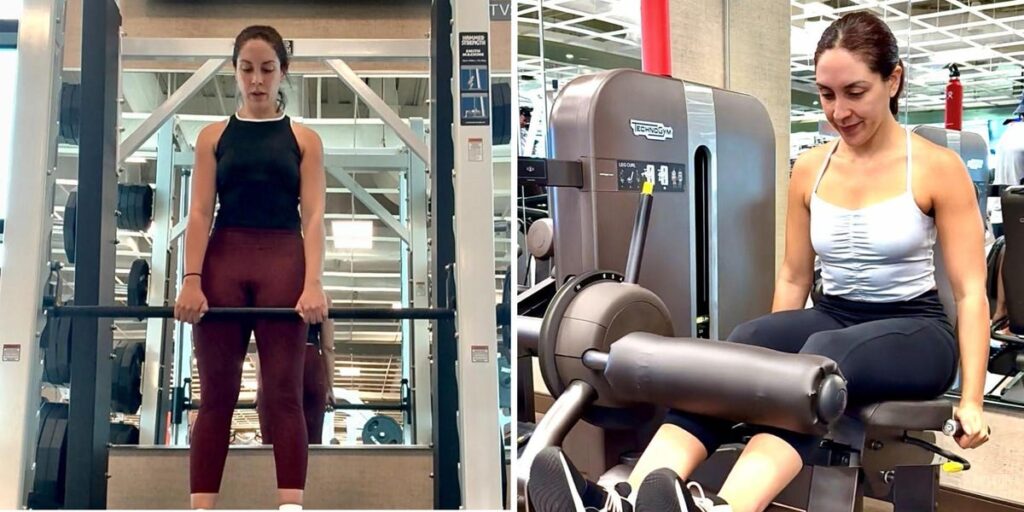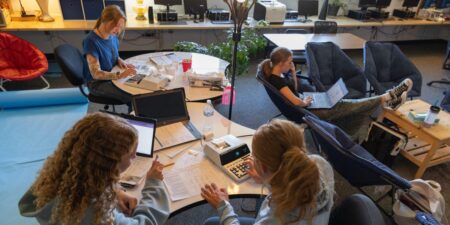Scarlett Espinoza was just getting serious about the gym when an accident set her back. She was practicing handstands at home in Miami, fell, and broke her ankle in three places.
It took her months to relearn how to walk. Espinoza, 38, was frustrated by how challenging even basic tasks were — and nervous about losing her stride. Seeing her parents aging had gotten her thinking more seriously about longevity.
“I didn’t want to be someone who couldn’t stand up from the couch or pick something up from the ground,” Espinoza told Business Insider.
Now, less than a year later, she’s back in the gym and stronger than she’s ever been.
Shortly after starting to exercise again, Espinoza joined a two-month challenge from Life Time Fitness and overhauled her routine.
Her results — losing 14 pounds, gaining 6 pounds of muscle, and cutting her body fat percentage in half — made her the national winner of the challenge with a $10,000 prize.
But the intense 60-day routine wasn’t sustainable; within a week, Espinoza found she was reverting to old habits that threatened to overturn her progress.
By focusing on strategies she could stick to, Espinoza adjusted to a flexible diet and exercise plan so she could maintain all her hard-earned results.
“It’s crazy when I think back to where I was a year ago,” she said. “I’m still not 100% but it makes me so happy to feel my body getting stronger and moving better.”
Here’s what she learned, from her exercise habits to her typical day of eating.
Commit to small habits first
For two months, Espinoza couldn’t put weight on her injured leg. When she was finally able to start using it again, the muscles on that side had shrunk dramatically.
“It was like a twig next to my other leg,” she said.
She started doing simple step-up exercises to work her single-leg strength, balance, and mobility. At first, she needed to hold on to the wall for support. Gradually, Espinoza regained her ability to move, one rep at a time.
“I did step-ups every single day as my warm-up. I couldn’t see the progress week to week, but the exercise really was helping me,” she said. “The first day I did a leg extension on the machine, I cried.”
Even now, a warm-up routine is a nonnegotiable before every workout, Espinoza said.
Focus on building strength
Once Espinoza was able to move regularly, she started lifting weights.
“I wanted to get strong, I wanted to be able to carry heavy things,” she said.
For an hour a day during the full two months of the challenge, Espinoza hit the weight room. She saved time by using exercise machines (which are quicker and less technical to use than a barbell) and by adapting to whatever machines were available so she didn’t have to wait in line.
“I went slow and focused on feeling my muscles, lifting as heavy as I could,” she said.
As she became stronger over time, Espinoza said she kept increasing the weight to challenge her muscles, a key technique for building muscle called progressive overload.
Initially, she also tried to add an hour of cardio each day, but that quickly turned into a slog. Instead, she switched to 15-20 minutes of low-impact cardio like cycling and aimed to get 8,000 steps per day.
Since the challenge ended, she’s also added a full day of rest each week.
Her daily diet — packed with fiber and protein
For the challenge, Espinoza completely overhauled her diet, aiming to build muscle and burn body fat with a small calorie deficit.
To do so, she started eating more protein, aiming for around 30 grams per meal, along with more fiber. Both protein and fiber can help with satiety, so you stay full for longer after eating.
“I used to barely eat protein, and most of my meals were carbs. I didn’t cut out carbs, but I cut back on ultra-processed foods,” Espinoza said.
However, her initial diet was extremely rigid: lots of chicken breast and turkey, mostly veggies for carbohydrates, and nothing to drink but water and protein shakes. Once the challenge ended, all of her cravings caught up to her, and the first week after was full of pasta, brownies, and everything else she’d been restricting.
She pivoted, sticking to her protein and fiber goals while giving herself more flexibility to enjoy food.
A typical day of eating for Espinoza includes foods like:
- Breakfast: Greek yogurt with berries, honey, and chia seeds
- Lunch: the biggest meal of the day, usually a large salad with chicken and plenty of veggies
- Snacks: Edamame, a good source of protein and fiber
- Dinner: Roasted veggies and legumes like black beans, and pasta when she feels like it.
- Dessert: a bite-sized cookie, ice cream sundae, or other small sweet treat.
“I’m not trying to just do a crash diet and go back to my old ways,” she said. “I need food to bring me joy, and a super clean, strict diet wasn’t going to do that for me.”
Read the full article here
















